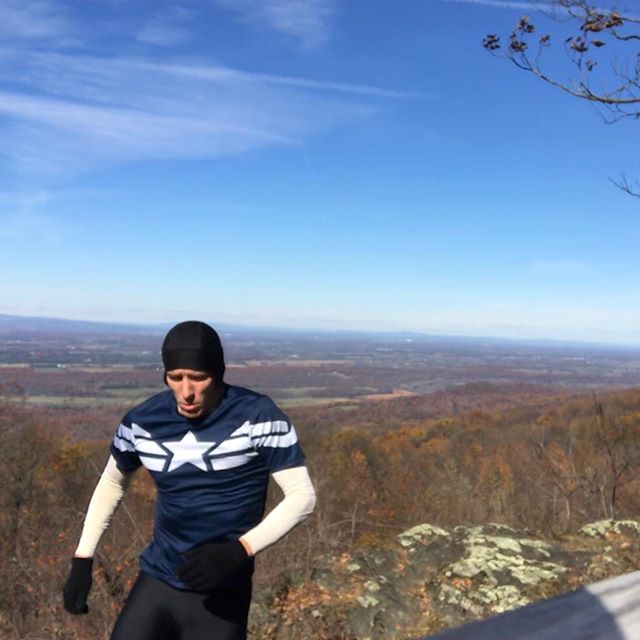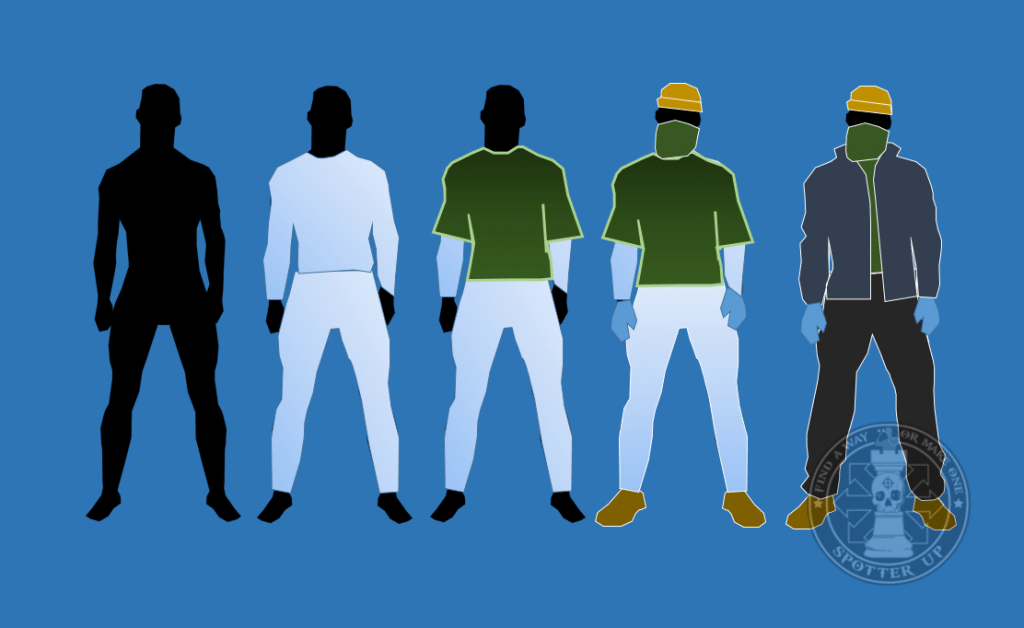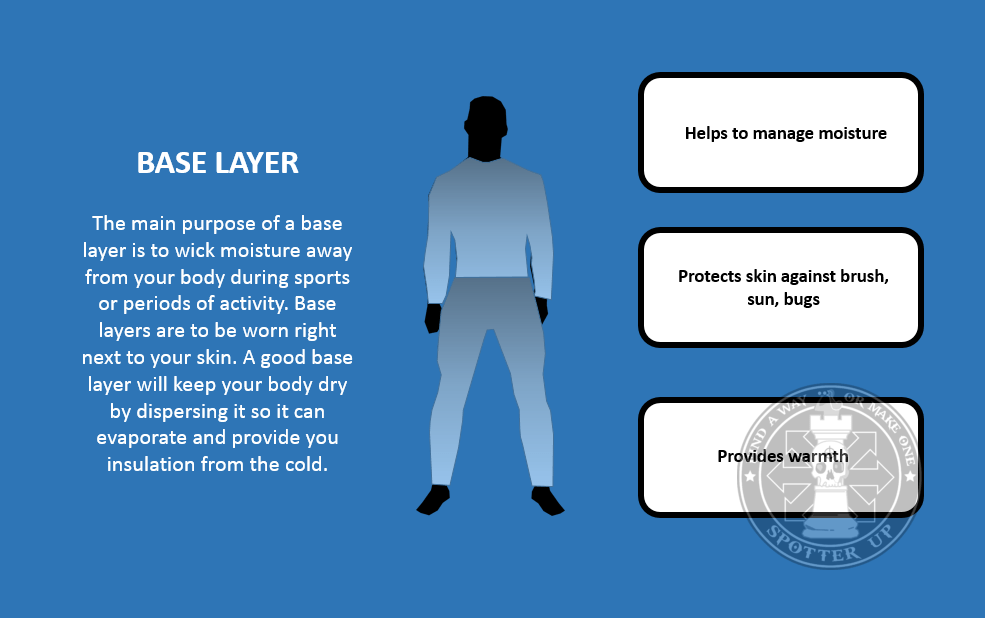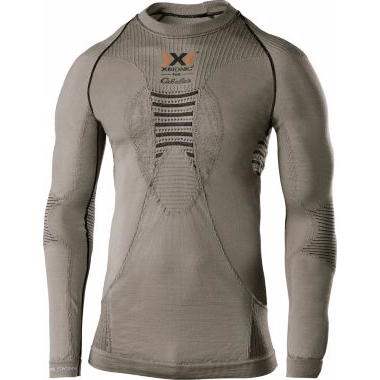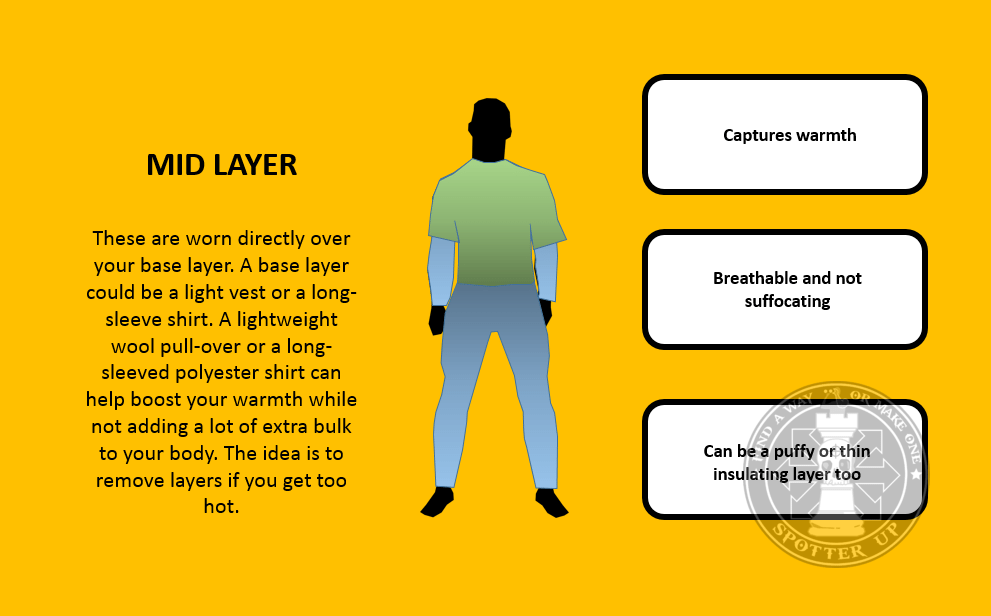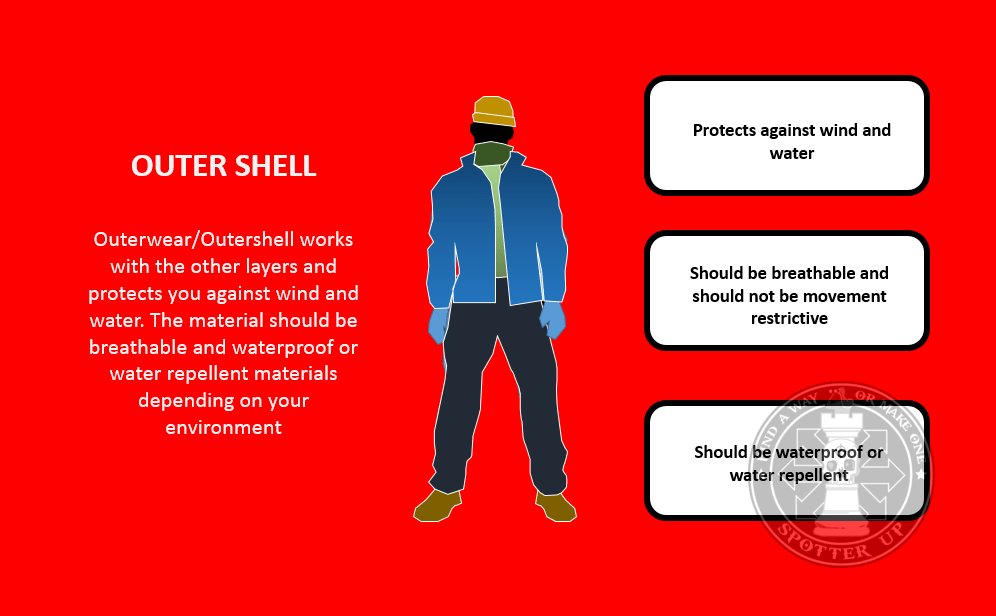It’s getting to be that time of year. Prepare or die!
My buddy takes my phone call and he tells me he’s wearing a t-shirt, jeans and working under his car. The California sun is blazing overhead. Meanwhile I’m getting ready for 30″ of snow and shivering as I’m walking to my mail box. Wherever you’re at and no matter what you’re doing ensure that you’re properly dressed. Some people are new to this, when it comes to layering clothing in cold conditions, so here we go.
To optimize your time in the outdoors try layering your clothing. There are three prescribed layers to give you the best protection and comfort. Each layer of clothing has a function and when combined properly with other layers they in unison will provide you comfort and shielding. Layering allows you to avoid being too hot or too cold by adding or removing your clothing layers to achieve the ideal level of protection and comfort.
Weather conditions, our daily activity, and even our environment can change and so using a combination of layers will help you achieve the ideal effect. Adaptability is the key to achieving the best level of protection and comfort for the conditions. Simply, add or subtract your layers as needed.
Base layer: The base layer is the layer worn closest to your skin. The main purpose of the base layer is to wick moisture away from your body during your periods of activity. It works to keep you dry and insulate you from the cold. To be effective it should be breathable while also being non-absorbent.
There are two main categories of base layers:
Synthetics: Synthetics are good because they are not itchy, are breathable, durable and dry very quickly. They are abrasion and wrinkle resistant. Some synthetics tend to collect odors faster than other synthetic materials or natural fibers but anti-bacterial agents are added. Synthetics are affordable and are moisture-wicking. Popular synthetics are polyester, polyethylene, microfiber and nylon. Manufacturers will often do blending. Nylon can be added for durability or cotton can be added for odor resistance but drying time could increase.
- Nylon: Nylon has more tightly woven fibers than polyester and therefore it doesn’t wick as well or dry as fast. It does not hold as much of an odor as polyester. Good for trekking pants. Long sleeve shirts or long underwear need vents cut into them if made from nylon because they don’t wick as well as polyester.
- Polyester: The most popular to use for base layering rather than nylon. It is excellent for use as a base layer because it is breathable, wicks moisture and dries fast but it holds an odor more than nylon or merino wool.
Natural: Wool layers and cotton layers are popular.
- Cotton does not have the wicking ability of most synthetics, does not dry quickly and therefore your base layer will remain damp and chilly after you sweat. Although it is comfortable on the skin it is recommended to use cotton only as a base layer for general wear but not for outdoor sports activities.
- Merino wool base layers are popular for their moisture-wicking and fast-drying properties but they do not dry as fast as synthetics. It tends to be odor-resistant and biodegradable as well although it might feel scratchy on the skin for some people, but not for most. Though it is more expensive than most synthetics it is an alternative to polyester. Potential to shrink, also remember that synthetic materials tend to collect odors faster than natural fibers.
There are different weights of base layers and each has advantageous and disadvantages-Thicker fabrics will provide more insulation than the thinner fabrics. Keep in mind that the thicker fabrics will retain more water than the thinner ones and also dry slower. One flip side to the thicker fabric is it acts as a barrier to moisture building up against the skin.

Lightweight Base Layers: Good for cool to cold conditions. Walking or hiking.
Mid-weight Base Layers: Good for cold weather and intermittent activity. Soccer, running, skiing and field hockey where you might stop and start.
Heavyweight Base Layers: Good for extremely cold weather and windy, sub-freezing conditions. Frigid temperatures.
Examples:
- Liner gloves
- Synthetic underpants
- Synthetic long underwear
- Liner socks
Mid Layer: These are worn directly over your base layer and provides additional insulation. A base layer could be a light vest or a long-sleeve shirt. A lightweight wool pull-over or a long-sleeved polyester shirt can help boost your warmth while not adding a lot of extra bulk to your body. The idea is to remove layers if you get too hot. Using multiple thin layers allows you to adjust your level of comfort and warmth. Try to use a mid-layer that is looser than the base layer. A loose mid-layer allows insulating air to flow between both layers. They key is to trap heat.
Cotton, Wool, Down and Fleece are all materials that can be used as a mid-layer. Cotton is inexpensive but not ideal for the outdoors as you will need insulation. A better option is wool or down. Down is great for added warmth but it tends to be expensive, makes your clothing bulky and it dries slowly. A parka with down is a good provider of insulation. Wool is good for insulation even when wet. It does not feel wet even when wet. Fleece is lighter than wool and provides good insulation.
Examples:
- Fleece vest
- Synthetic pants
- Synthetic shirt
- Thick socks
- Boots, waterproof and roomy for thick socks
- Cap
- Goggles for wind
- Lip balm
- Mittens or light gloves
- Neck Gaiter
- Scarf
- Sunscreen
Outerwear Layer: Outerwear should be selected smartly. The key is to cut out the wind and keep you dry. You can wear a light, rain repellent-shell or a heavy-duty waterproof jacket. This is the most important piece of your layering clothing because conditions and environments can change quickly in the outdoors. You can hike in snowy conditions that get very windy quickly or perhaps you begin hiking and then get hit by a heavy downpour.
It is recommended to select good pair of pants and jacket. Select breathable and waterproof or water-repellent materials depending on where you plan to use them. Keep in mind to leave a bit of room within your outer shell for layering beneath. Purchasing outwear that is too small will not allow you to layer properly and your movement will be restricted.
Examples:
- Down jacket
- Leg gaiters
- Outerwear jacket with hood-waterproof or water-repellent rain jacket
- Outerwear gloves-waterproof or water-repellent
- Outerwear pants-waterproof or water-repellent
Get rid of that old military gear passed down to you from the WW II inventory your reserve unit issued you. Best time to buy is right after the Winter is over and stores are clearing out their inventory. It may take you a while to build a good closet full of usable gear but it’s worth it to be methodical about what you want versus what you need. Buy the best that you can afford and choose utility over style first. If you find both for a good price then go for it.
Looks cold to me

